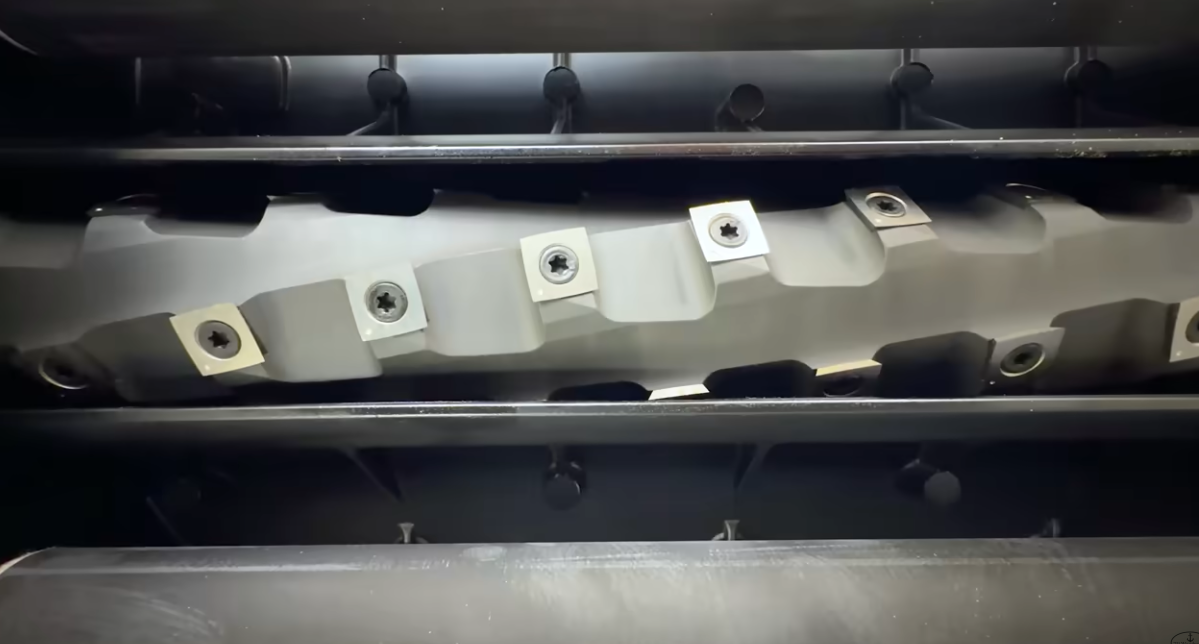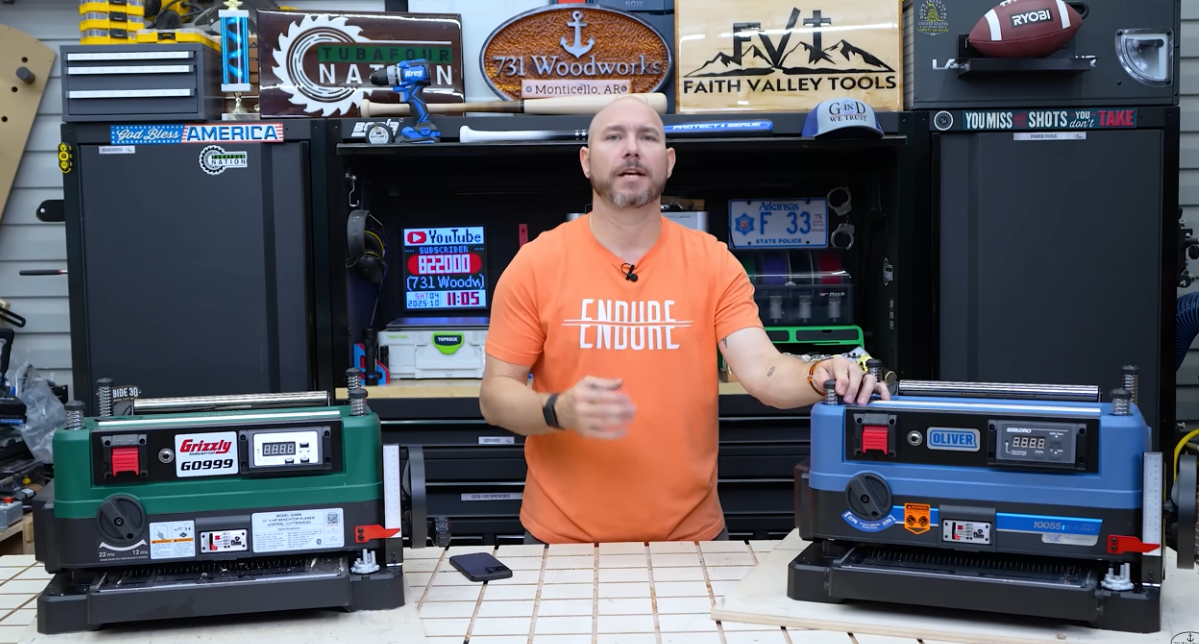I Tested Two of the Hottest 15-Inch Planers in Woodworking (Here’s the Truth)
When it comes to woodworking, few tools make a bigger difference in your final results than a good planer. Lately, two 15-inch machines have been stealing the spotlight — the Oliver 15-Inch Helical Head Planer and the Grizzly 15-Inch Planer. They look nearly identical, they come from the same factory, and yet one costs $800 more than the other. So, which one’s really worth your money?
After weeks of testing, comparing, and planing everything from pine to leopardwood, here’s the honest truth — from one woodworker to another.
Affiliate Disclaimer
This post contains affiliate links, which means I may earn a small commission if you buy through them—at no extra cost to you. It helps keep the tool deals coming, so thanks for your support! Prices are valid at the time of posting but are subject to change at any time.
Watch The Full Youtube Video Here: Incredible NEW Woodworking Tool That's On Another Level! (genius new planer)
Unboxing and First Impressions
Both planers arrived by freight truck — and let me tell you, these machines are heavy. The Oliver 15-Inch Planerweighs around 135 lbs, so you’ll need a buddy to help you get it on the bench.
👉 Check out the Oliver 15-Inch Planer here: Oliver 15-Inch Planer – Amazon
The Grizzly 15-Inch Planer, which you can find at Home Depot, comes in a nearly identical crate.
👉 See the Grizzly 15-Inch Planer here: Grizzly 15-Inch Planer – Home Depot
Both were well-packaged and easy to assemble. The Oliver includes infeed and outfeed tables — something the Grizzly skips, though you can add them later.
Each also uses a Lightning Lock dust collection port, which I highly recommend if you want quick hose changes between tools.
👉 Grab the Lightning Lock adapters here: Lightning Lock Dust Collection Adapters – Carbon Method
Build Quality and Setup
The Oliver feels like a “pro-sumer” level machine. With 15-inch width capacity, 6-inch height, and positive turret stops, you can plane wood from 3/16" up to 6" thick with precision.
It even comes with a Digital Readout (DRO) — or DRRO, as they call it — so you can zero out and perfectly match board thicknesses.
✅ Pro Tip: The DRO on the Oliver is much easier to read than the Grizzly’s, with bright blue digits. But both still show a little “ghosting,” something I wish they’d improve.
Both planers use four synchronized ball screw posts, keeping everything level when you raise or lower the cutter head. The action is butter smooth, and there’s no wobble at all.
Helical vs Spiral Cutter Heads
Here’s where things get interesting. The Oliver 15-inch Planer comes with a helical cutter head — 40 angled carbide inserts that shear the wood for a smoother finish.
The Grizzly, meanwhile, uses a spiral head, which has straight inserts that chop the wood instead of shearing it. That might not sound like a big deal, but the difference shows up fast on hardwoods and figured species.
👉 Check the helical head upgrade option here: Helical Upgrade for DW735X – Amazon
👉 Or get it pre-installed: DW735X with Byrd Shelix Cutter – Collabs Shop
The Oliver’s helical design produced near-perfect finishes, even on tricky species like quilted maple and leopardwood, where most straight-knife planers tear out chunks of grain.
If you’re working mostly with pine or walnut, both planers perform beautifully. But if you love exotic hardwoods, the Oliver’s extra smoothness is worth the premium.
Performance Testing: Real Wood Results
To make this a fair fight, I planed several boards through both machines — from southern yellow pine to black walnut, quilted maple, and leopardwood.
Here’s how they stacked up:
Pine: Both planers handled softwood easily. Smooth, fast, and surprisingly quiet.
Walnut: The Oliver delivered a glass-smooth finish with less sanding required.
Quilted Maple: Virtually no tear-out on the Oliver, minor on the Grizzly.
Leopardwood: This was the true test. The Grizzly showed visible tear-out, while the Oliver’s helical head left a cleaner surface.
👉 Need a more compact option? Check out the Oliver 13-Inch Planer. It has a helical head and digital readout too, but runs on 120 volts — perfect for small shops.
Power Requirements and Noise
This is where most buyers will make their decision.
Oliver 15-Inch Planer: Runs on 230 volts, 2.5 horsepower. You’ll need a 230V outlet or dedicated circuit.
Grizzly 15-Inch Planer: Runs on 120 volts, 20 amps, and uses a 5-20 plug (horizontal/vertical prong combo).
👉 If you go the Grizzly route, use a heavy-duty 5-20 extension cord like this one on Amazon.
Noise-wise, both planers are impressively quiet compared to older straight-knife planers like the DeWALT DW735X— still one of the most popular entry-level models.
👉 Compare with the classic: DeWALT DW735X Planer – Amazon
Price and Shipping: The Deal Breaker
Now for the part that ruffles feathers — the price.
Oliver 15-Inch Helical Head Planer: $1,869.99 + $400 freight shipping
Grizzly 15-Inch Planer: $1,450 with free shipping from Home Depot
That’s roughly an $819 difference. And honestly, that $400 shipping fee on the Oliver feels excessive. I’ve had much larger tools shipped for half that.
Still, if you’ve got the budget and 230V power, the Oliver is a rock-solid performer. But if you’re looking for value and already wired for 120V, the Grizzly gives you 90% of the performance for a lot less cash.
Matt’s Honest Take
If budget and power setup aren’t a problem, go for the Oliver. It’s smoother, quieter, and delivers premium results on every species I ran through it.
If you’re looking for best bang for your buck, the Grizzly is a powerhouse in its own right. You’ll lose the infeed/outfeed tables and a bit of polish, but the core performance is still fantastic.
And if you’re just getting started and want a smaller footprint, the Oliver 13-Inch Helical Planer gives you a ton of value with standard 120V power.
Shop the Tools Mentioned
Buy Hardwood Online from Our Trusted Partner – O’L Loggin Sawmill
Pre-Installed DW735X with Byrd Shelix Helical Cutter – Collabs Shop
Final Thoughts
Both the Oliver and Grizzly 15-inch planers prove that high-end woodworking tools are more accessible than ever. Whether you’re running exotic hardwoods or framing-grade pine, these machines deliver pro-level performance right in your home shop.
Remember — no matter which planer you choose, safety comes first. Always unplug before servicing, use proper dust collection, and never feed short stock through your planer.
If you enjoyed this comparison, be sure to check out more reviews and woodworking tips right here on the blog.
You got this — now go make some sawdust!






